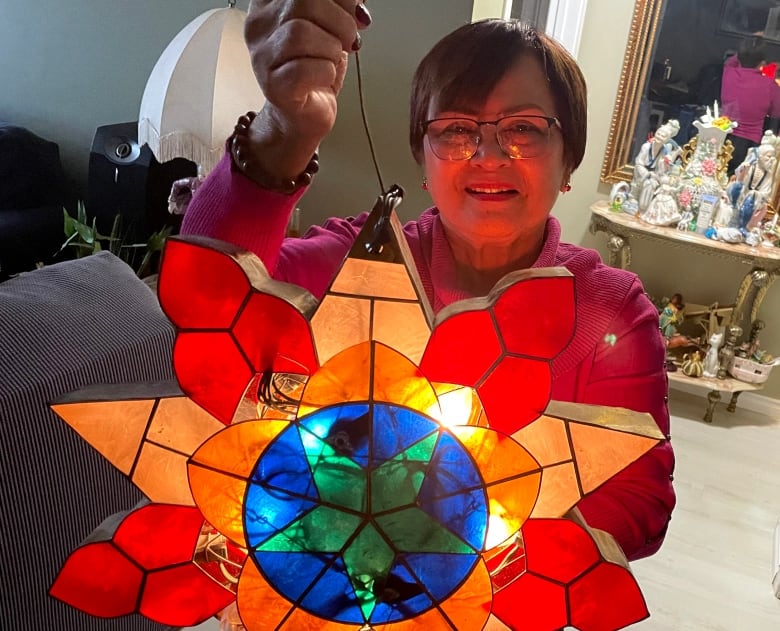
This First Person article is written by Jim Agapito, the host of the CBC Radio One holiday special, Recovering Filipino: Longest Christmas Season in the World. For more information about CBC’s First Person stories, please see the FAQ.
Recovering Filipino49:01Why is my tita wishing me Merry Christmas in August?
So I must admit. I’m a grinch, and I hate Christmas.
Well, hate is too strong of a word. Let’s use dislike. Yes, I dislike Christmas.
But for the majority of the 10.2 million Filipinos worldwide, Christmas is a big deal. It starts at the beginning of September and ends in January. It’s my nightmare, but for my mom, Yolanda, and grandma, Lola, it’s their favourite time of the year.
Why is Christmas such a big deal in the Philippines? Yolanda and Lola say it’s because of that exceptional someone: baby Jesus. My mom’s bedroom is filled with Santa Nino or Jesus dolls dressed in the most regal and ornate attire. Lola says it’s about Christ, my mom says it’s also about the kids, and I think it’s a hallmark of commercialism.
I didn’t always hate Christmas. But when my auntie Linda and uncle John, with whom I spent most of my childhood Christmases, died of cancer, my joy for the season froze over like the Manitoba winters I must endure.
My Uncle John and Auntie Linda, or Dada, as I called her, had no children. My brother and I were their surrogate children. From a young age, and even as a teen, I slept over at their place after the Christmas Eve party my family would have. I would wake up and celebrate Christmas with them, opening the gift I had asked for under the tree. It was the best. When they died, I stopped caring about Christmas. In fact, I avoided it.

I was 25 at the time. However, it’s nearly impossible to escape from the epic way Filipinos celebrate Christmas. Now that’s been nearly two decades since my relatives passed, I decided to try to understand why Filipinos are so passionate about the season. Instead of dwelling on the loss of my family members, perhaps it could help change my attitude toward the holiday. I was skeptical, but I figured it was worth a shot.
To start, if I could understand why the festive season lasts so long, it might be the key to changing my attitude. After all, my mom says loving Christmas is critical to being a true Filipino.
Yolanda said the Christmas season must stretch through all of the “-ber” months — the ones that end in ‘ber’ like September and October. When I asked her why, she couldn’t answer.
Carolling for cash
I asked professor Fides del Castillo, a Filipino Christmas expert from De La Salle University in the Philippines. She said it’s because the Philippines has two seasons — the warm season and the cool season. The “-ber” months represent when it gets colder in the Philippines and the change of season represents the start of the Christmas season.
When I asked del Castillo why my mom was always going to church during the season, she said it was because of the nine days of Simbang Gabi or dawn mass. In the Philippines, it’s tradition for people to wake up at 3 a.m. and walk to the church. You wake up all your neighbours by clapping — indicating it’s time to go. While the pre-dawn mass tradition has changed over the past couple of decades (churches have adapted by holding masses in the evening so that people can make it to work in time), my mom and Lola still wake up early.
I get that this is rooted in the Filipino Christmas tradition, but what’s the buy-in for young people?
I met my cousins Kaye and Richie Galang to find out. They brought their partners, Glora-Lynn and Julie, to tell me why over breakfast. Julie said that if we had met at their house, I would’ve seen the Christmas tree they had up since September.
Yikes.

Having come to Canada only in the last decade, my cousins are still trying to grasp the Canadian Christmas.
“In Canada, you get a gift in a box, but in the Philippines, you get cash. Cash is king,” said Richie.
His wife, Julie, pointed out that we spend two days celebrating Christmas in Canada. In the Philippines, they start carolling on Dec. 1. And you know what your reward for doing that is? More cash.
Kaye says the cash is half the fun of Christmas in the Philippines. As kids, they would carol and make enough money to get snacks throughout the day.
I would’ve carolled for cash as a kid. Heck, I’d do it today for a good meal. But looking back, I realize that I always got money for Christmas growing up. That was fine with me. I could buy all the stuff I wanted on Boxing Day, like that memorable time in 1986 when I bought clothing and my first tape — the soundtrack to the movie Cocktail.
Spoiling the kids
Julie reminded me that, for a lot of Filipinos, the Christmas season starts when a special someone pops on your social media in late August. That person is Jose Mari Chan or “Mr. Christmas.” Think of him as the Micheal Bublé of Filipino Christmas, but way more religious. Filipinos in the Philippines know the Christmas season is upon them when his tune Christmas In The Heart starts playing over the mall PA in September. Here in Canada we all have that one friend who insists on playing Christmas music right after Halloween. Well, if we lived in the Philippines, they’d be two months late to the game.
Even my Muslim Filipino friend Alia Rasul gives into the Christmas spirit. Every year, the comedian embraces the festive spirit by playing Jose Maria Chan on regular rotation, even though she doesn’t believe in the baby Jesus and Christmas.
For her Filipinx comedy troupe, the Tita Collective, Christmas is a special time. Most of its performers were raised in Filipino Christmas traditions, so Alia joins all the parties, food, performances and Christmas fun her cohorts celebrate. She said that’s the great part about being Filipino at Christmas time — that we share a unique sense of community like no other. Culture and community are at the heart of the festive season for Alia.
So while I hoped Alia would join the grinch-me in disliking Christmas, she was instead a voice of reason for giving Christmas another shot.
As part of this process, I tried to get creative. I learned how to make a Christmas parol — a Filipino lantern in the shape of a star that symbolises the North Star the wise men followed to find Jesus — and listened to Filipino Canadian children sing carols. When I visited the A. E. Wright Community School in Winnipeg as part of my research, the students sang Silent Night in Tagalog and told me what they love about Filipino Christmas. All of their stories melted my ice-cold heart bit by bit. But it didn’t click into place for me until my mom reminded me what Christmas is about. All these traditions are repeated year after year for all the children who enjoy Christmas.
Although I no longer have my Auntie Linda or Uncle John to celebrate with each year, I do have a niece and nephew who love me immensely. Miku and Yuto know Uncle Jim will spoil them rotten for Christmas, just as my aunt and uncle did for me.
So maybe my grinch-like heart can grow three times bigger if it makes them happy. That, in itself, is the greatest gift I can get. Perhaps it’s reason enough to start loving Christmas.
Do you have a compelling personal story that can bring understanding or help others? We want to hear from you. Here’s more info on how to pitch to us.